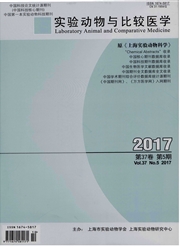

 中文摘要:
中文摘要:
目的探讨姜黄素对大鼠缺氧缺血性脑损伤(hypoxia—ischemic brain damage.HIBD)后丙二醛(malondjaldehyde,MDA)含量和c—fos蛋白表达的影响。方法将SD雄性大鼠随机分为假手术对照纽、脑缺氧缺血组、姜黄素组和溶剂对照组。用比色法测定脑组织中MDA含量,免疫组织化学方法检测脑皮质区c—fos蛋白的表达,电镜观察脑皮质神经元的形态学变化。结果姜黄素干预组与其他组的相应时间段相比,MDA含量下降,脑皮质区c—fos蛋白表达显著增高(P〈0.05)。电镜观察脑皮质神经元损伤减轻。结论姜黄素可降低HIBD大鼠脑组织的MDA含量,上调c-fos蛋白的表达,减轻神经元的损伤。
 英文摘要:
英文摘要:
Objective To explore the effects of curcumin on the content of malondialdehyde(MDA) and the expression level of c-fos protein following hypoxia ischemia brain damage(HIBD) in rats. Methods Sprague- Dauley(SD) rats were randomly divided into four groups as the following: sham group, hypoxia ischemia brain damage group, curcumin group and solvent control group. The content of MDA in the brain was measured by colorimetry. The expression level of c-fos protein in the cortex tissue was detected by immunohistochemistry. Morphologic and structural changes of neuron cells of the cortex were observed by electron microscopy. Results The content of MDA was clearly lower in curcumin group than that in the other groups at the same time after HIBD. The expression level of c-fos protein was higher in the curcumin group than that in the other groups (P〈0.05). Electron microscopy showed that the morphologic and structural changes of neuron cells of cortex in the curcumin group were reduced. Conclusion Curcumin could significantly decrease the content of MDA, increase the expression level of c-fos protein and reduce the damage of the neuron ceils.
 同期刊论文项目
同期刊论文项目
 同项目期刊论文
同项目期刊论文
 期刊信息
期刊信息
